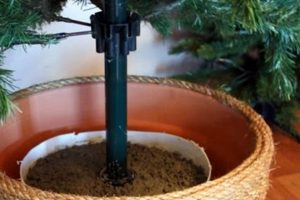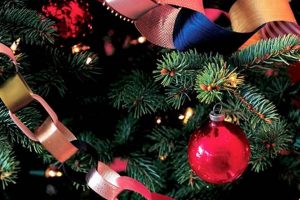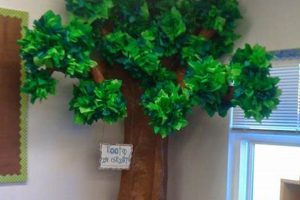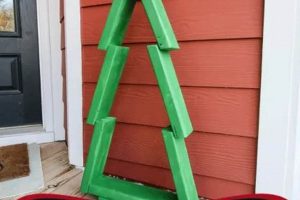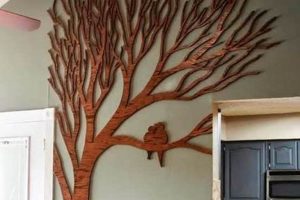A custom storage solution that mimics the branching structure of a tree provides an aesthetically pleasing and functional way to organize reading materials. These constructions are typically built from wood or engineered wood products and can be designed to fit various spaces and aesthetic preferences. An example would be a unit constructed from plywood, shaped to resemble a stylized tree silhouette, with shelves integrated along the “branches” to hold books.
This approach to book storage offers numerous advantages. It provides a visually engaging alternative to conventional bookcases, adding a unique design element to any room. Further, the project encourages creative expression through customization of size, shape, and finish. Historically, unique and bespoke furniture pieces have been valued for their individuality and contribution to the character of a space; this continues that tradition.
The subsequent sections will explore different construction methods, design considerations, and safety precautions relevant to the creation of this distinctive piece of furniture. Detailed instructions and material recommendations will enable readers to successfully complete their own project.
Practical Considerations for a Custom Arboreal Bookcase
The creation of a distinctive branching bookcase requires careful planning and execution. Adherence to the following guidelines will promote a successful outcome.
Tip 1: Precise Measurement is Paramount. Prior to commencing construction, accurately measure the intended space. Account for height, width, and depth limitations to ensure the finished product fits seamlessly within the environment. Failure to do so may result in a structure that is either too large or too small for its intended location.
Tip 2: Material Selection Dictates Longevity. Opt for high-quality materials such as hardwood plywood or solid wood. These materials offer superior strength and durability compared to less expensive alternatives. Properly sealed and finished wood will resist moisture damage and insect infestation, thereby extending the lifespan of the bookcase.
Tip 3: Structural Integrity Requires Reinforcement. The branching design necessitates robust joinery techniques. Employ methods such as mortise and tenon joints, dowel joints, or pocket hole joinery, supplemented with wood glue, to ensure a stable and load-bearing structure. Reinforcement at critical junctures will prevent sagging or collapse under the weight of books.
Tip 4: Prioritize Safety Through Secure Mounting. Due to its height and potential instability, anchoring the structure to a wall is crucial, particularly in households with children or pets. Use appropriate wall anchors designed to support the weight of the bookcase and its contents. Regularly inspect the anchors for signs of loosening or wear.
Tip 5: Optimize Shelf Placement for Accessibility. Arrange shelf spacing to accommodate a variety of book sizes. Adjustable shelves offer greater flexibility, allowing for customization based on the user’s collection. Consider placing heavier volumes on lower shelves to maintain stability and minimize the risk of toppling.
Tip 6: Finishing Enhances Aesthetics and Protection. A well-applied finish not only enhances the appearance but also protects the wood from scratches, stains, and moisture. Apply multiple coats of primer and paint, or a clear coat of varnish or polyurethane, allowing each coat to dry thoroughly before applying the next. Sand lightly between coats for a smooth, professional finish.
Tip 7: Consistent Testing of Weight Bearing. Before completely filling the bookcase with books, gradually load the shelves with weighted items to test its stability and weight-bearing capacity. Observe for any signs of stress or deformation. Adjustments or reinforcements may be necessary before full utilization.
By adhering to these guidelines, the creation of a functional and aesthetically pleasing arboreal bookcase is achievable. Careful planning, appropriate material selection, and diligent execution are essential for a long-lasting and safe addition to any space.
The concluding section will address common challenges and offer solutions to troubleshoot potential issues that may arise during the construction process.
1. Structural Stability
Structural integrity is paramount in the construction of any free-standing bookcase, and this is particularly critical in the case of a custom arboreal design. The branching form introduces complex load distribution challenges that must be addressed to ensure the safety and longevity of the finished piece.
- Joint Integrity
The points at which branches connect to the central trunk, and where shelves attach to the branches, are subject to significant stress. Weak or improperly executed joints can lead to cracking, separation, or complete failure. Mortise and tenon, dovetail, or reinforced dowel joints, paired with high-strength wood glue, are essential for creating durable connections. Example: A branch extending outwards to hold a heavy load of books needs a robust joint to the trunk, otherwise the branch may shear off or sag significantly.
- Material Selection
The choice of material directly impacts the structure’s ability to withstand weight and resist deformation. Solid hardwoods, such as oak or maple, offer superior strength but can be more expensive and difficult to work with. High-quality plywood offers a cost-effective alternative, providing good strength and stability when properly supported. Example: Using thin, low-grade plywood for the shelves will result in sagging under the weight of books, regardless of the joint quality. Selecting a thicker, higher-grade plywood, or incorporating a support structure underneath, will prevent this issue.
- Base Support and Weight Distribution
The design of the base must provide a stable platform to prevent tipping, especially when the bookcase is fully loaded. A wide base, or anchoring the structure to the wall, is crucial for stability. Distributing the weight of the books evenly across the shelves minimizes stress on individual joints and prevents uneven loading. Example: A narrow base supporting a tall, heavily loaded tree bookcase is highly susceptible to tipping. A wider, more substantial base, or wall anchoring, would significantly improve stability.
- Load Capacity and Shelf Design
Each shelf must be designed to support the anticipated weight of the books. Consider the thickness of the shelf material, the span between supports, and the type of books to be stored. Reinforcing shelves with a backing or edge banding can significantly increase their load-bearing capacity. Example: Long, unsupported shelves made of thin material will bow or break under the weight of books. Shortening the shelf spans or adding a central support will increase their weight capacity.
The successful construction of an arboreal bookcase hinges on a thorough understanding of structural principles. By carefully considering joint integrity, material selection, base support, and load capacity, it is possible to create a unique and visually striking piece of furniture that is also safe and durable. The balance between aesthetic design and structural soundness is key to a lasting project.
2. Aesthetic Design
Aesthetic design constitutes a critical element in the conception and construction of a bespoke, arboreal bookcase. The visual appeal of the finished product directly influences its integration into a given interior space and contributes to the overall ambiance of the room.
- Branching Pattern and Silhouette
The arrangement and style of the “branches” form the dominant visual characteristic. Designs range from highly realistic depictions of specific tree species to abstract interpretations with geometric lines. The silhouette impacts perceived space and influences the piece’s compatibility with diverse interior design themes. For example, a bookcase mimicking the weeping willow silhouette introduces a sense of organic fluidity, contrasting with a more angular, modern aesthetic.
- Material and Finish Selection
The selection of wood, paint, stain, or other finishing materials significantly affects the aesthetic. Natural wood tones impart warmth and a sense of rustic charm, whereas painted finishes allow for customization to match existing color schemes. The texture and sheen of the finish also contribute to the overall visual impression. A high-gloss finish might lend a contemporary feel, while a matte finish offers a more understated and classic look.
- Shelf Configuration and Book Display
The placement, size, and orientation of the shelves determine how books are displayed and contribute to the overall visual composition. Asymmetrical arrangements can create a dynamic and visually interesting effect, while symmetrical layouts provide a more organized and formal appearance. Consider book sizes and color to enhance the bookshelf’s aesthetic appeal. For example, carefully curated arrangements of books by color can create visual harmony, and bookends in complementary styles can further enhance the display.
- Scale and Proportion
The overall size of the structure in relation to the room’s dimensions is crucial for visual harmony. A bookcase that is too large can overwhelm the space, while one that is too small may appear insignificant. Proportion also affects visual appeal; branches that are too thin or too thick in relation to the trunk can disrupt the overall aesthetic balance. For example, a very tall, narrow bookshelf in a small room may feel imposing and unbalanced, while a lower, wider design may be more harmonious.
The convergence of these aesthetic considerations directly informs the successful integration of an arboreal bookcase into its intended environment. A well-designed structure not only serves a functional purpose but also acts as a focal point, enhancing the aesthetic quality of the space. The specific aesthetic choices will depend on the individual’s taste and the overall design theme of the room, and are instrumental in realizing the unique character of the “diy tree bookshelf”.
3. Material Durability
Material selection directly impacts the longevity and structural integrity of a custom tree bookcase. Durability is a crucial consideration, as the unit must withstand the weight of books and resist environmental factors that can degrade its condition over time. The choice of materials significantly influences the bookcase’s resistance to wear, potential for damage, and overall lifespan.
- Wood Type and Hardness
The species of wood used in construction determines its resistance to dents, scratches, and abrasion. Hardwoods, such as oak, maple, and walnut, offer greater durability compared to softwoods like pine or fir. The Janka hardness scale provides a quantitative measure of a wood’s resistance to indentation. For example, a bookcase constructed from red oak (Janka hardness of 1290 lbf) will exhibit greater resistance to surface damage than one built from pine (Janka hardness of 380 lbf). The selection of an appropriate wood hardness level is critical for withstanding daily use and maintaining the bookcase’s aesthetic appeal.
- Moisture Resistance and Treatment
Wood is susceptible to moisture-related damage, including warping, swelling, and rot. Exposure to humidity or water can compromise the structural integrity of the bookcase and lead to unsightly discoloration. Selecting naturally moisture-resistant wood species, such as cedar or redwood, or applying a sealant or finish, provides protection against moisture absorption. Example: A bookcase placed in a humid environment without proper sealing may experience dimensional changes and fungal growth, reducing its lifespan. Effective moisture management is crucial for preserving the bookcase’s structural integrity and appearance.
- Joint Strength and Fastener Selection
The durability of the joints that connect the different components of the bookcase is essential for its overall stability. Weak or poorly constructed joints can fail under the weight of books or during movement. Employing robust joinery techniques, such as mortise and tenon or dovetail joints, and using high-quality fasteners, such as screws or bolts, ensures the joints can withstand stress and remain secure over time. Example: A bookcase constructed with weak glue joints and insufficient fasteners may exhibit wobbling or collapse under load. Strong and reliable joints are essential for a durable and long-lasting structure.
- Finish and Protection Against UV Exposure
Exposure to ultraviolet (UV) radiation from sunlight can cause wood to fade, discolor, or become brittle. Applying a finish that contains UV inhibitors helps protect the wood from the harmful effects of sunlight. Finishes also provide a barrier against scratches, stains, and other surface damage. Example: A bookcase placed near a window without UV protection may experience fading or yellowing over time. A durable finish enhances the bookcase’s aesthetic appearance and protects it from environmental degradation, extending its lifespan.
The interaction of these durability facets is paramount to the success of the arboreal bookcase. The choice of wood, the mitigation of moisture issues, the solidity of the joinery, and the appropriate finish all collaborate to create a lasting piece. Careful consideration of material durability is not just a matter of construction; it is a commitment to longevity and sustained aesthetic value for the unique piece of furniture.
4. Spatial Efficiency
Spatial efficiency, in the context of an arboreal bookshelf, concerns the maximization of book storage within a defined area. The design directly influences the volume of books accommodated per square foot, which is a key consideration in smaller living spaces. Unoptimized designs can lead to wasted space and a cluttered appearance. Conversely, a strategically designed unit allows for a greater collection to be stored compactly, making it a functional asset rather than a space-consuming liability. A prime example of this efficiency lies in designs that utilize the vertical dimension effectively, extending upwards to exploit unused wall space. The branching structure itself should be carefully considered; denser branching allows for more shelves, but can also create inaccessible nooks if not planned properly.
The practical significance of understanding this relationship lies in the ability to tailor the bookshelf to specific needs and room dimensions. Through careful planning and customization, it is possible to create a unit that maximizes storage while minimizing its physical footprint. For example, shelves of varying depths can accommodate books of different sizes, preventing wasted space behind smaller volumes. Angled shelves can allow books to be stored at a slight incline, increasing the number of books that fit on a given shelf length. The design can even integrate storage for non-book items, such as plants or decorative objects, further enhancing its functionality without sacrificing spatial efficiency. Additionally, strategically placing the bookshelf in an unused corner can transform a neglected area into a focal point of storage and visual appeal.
In summary, spatial efficiency is an indispensable element in the design and construction of a tree bookshelf. It directly impacts the units practicality and its integration into the living space. Challenges may arise in balancing storage capacity with aesthetic considerations, but a thoughtful approach to the branching pattern, shelf configuration, and overall dimensions allows for a seamless fusion of form and function. By prioritizing spatial efficiency, the bookshelf becomes a valuable asset, adding both utility and visual interest to the home.
5. Customization Options
The inherent adaptability of a handcrafted arboreal bookshelf presents significant customization opportunities. These options range from dimensional tailoring to nuanced aesthetic adaptations, allowing for the creation of a piece that seamlessly integrates with existing dcor and addresses specific storage requirements.
- Dimensional Adaptation
The ability to modify height, width, and shelf depth is fundamental. Room dimensions and the scale of book collections necessitate bespoke measurements. For example, a compact apartment may demand a vertically oriented design to conserve floor space, while a larger home could accommodate a sprawling, multi-branched structure. Failure to properly scale the bookshelf can result in visual disharmony or functional limitations. Dimensional precision is crucial for a harmonious integration into the designated environment.
- Branching Configuration and Style
The number, angle, and curvature of the “branches” can be tailored to reflect aesthetic preferences or functional requirements. A minimalist design might feature sparse, straight branches, while a more elaborate interpretation could incorporate a dense network of curved elements. This choice affects both visual appeal and book accessibility. An asymmetric branch arrangement can add visual interest but might require careful consideration of weight distribution to maintain stability.
- Material and Finish Selection
Material choices extend beyond basic wood selection to encompass various engineered wood products, metals, and composite materials. The final finish can range from natural wood tones to custom-matched paint colors, allowing for seamless integration with existing furniture. Different wood types and finishes offer varying degrees of durability and visual impact. Selecting materials that complement the room’s color palette and architectural style enhances the overall aesthetic coherence.
- Integrated Features and Accessories
Beyond basic shelving, additional features can be incorporated, such as integrated lighting, hidden storage compartments, or display areas for decorative objects. These additions enhance functionality and personalize the bookshelf to specific user needs. For instance, embedding LED strip lights within the branches can illuminate the book titles and create a visually striking display. Incorporating a small cabinet at the base can provide concealed storage for items not intended for public view.
These customization options underscore the unique value proposition of a handcrafted arboreal bookshelf. The ability to tailor every aspect of the design, from basic dimensions to integrated features, ensures that the finished product is not merely a functional storage solution, but a personalized work of art that reflects the owner’s individual style and storage needs. The convergence of these customization possibilities offers a transformative experience, yielding a uniquely tailored structure.
Frequently Asked Questions
The following questions address common concerns and provide concise answers regarding the construction and design of a custom, arboreal bookcase.
Question 1: What is the optimal type of wood for constructing a durable tree bookshelf?
Hardwoods such as oak, maple, or birch provide superior strength and resistance to wear compared to softwoods like pine. High-quality plywood, particularly birch plywood, also offers a cost-effective and structurally sound alternative, especially when properly supported.
Question 2: How can the stability of a tall, narrow tree bookshelf be ensured?
A wide base provides a stable foundation. Securely anchoring the bookshelf to a wall using appropriate hardware is strongly recommended, particularly in households with children or pets. Distributing the weight of books evenly across the shelves also contributes to stability.
Question 3: What are the recommended joint types for connecting branches to the central trunk?
Mortise and tenon joints, dovetail joints, or reinforced dowel joints, used in conjunction with high-quality wood glue, offer the most robust and durable connections. Pocket hole joinery may be suitable for less critical joints, but should not be relied upon for primary structural support.
Question 4: How can the bookshelf be protected from moisture damage and insect infestation?
Applying a sealant or finish, such as varnish, polyurethane, or paint, provides a protective barrier against moisture. Wood preservatives can also be applied to prevent insect infestation. Regular inspection and maintenance are essential for detecting and addressing any signs of damage.
Question 5: What are the key considerations when designing the shelf configuration for a tree bookshelf?
Shelf spacing should accommodate a variety of book sizes. Adjustable shelves offer greater flexibility. Heavier books should be placed on lower shelves to maintain stability. Consider incorporating different shelf depths to maximize space utilization and accommodate books of varying sizes.
Question 6: How can a professional-looking finish be achieved on a DIY tree bookshelf?
Proper surface preparation is essential. Sand the wood smooth before applying any finish. Apply multiple thin coats of primer and paint, or a clear coat of varnish or polyurethane, allowing each coat to dry thoroughly before applying the next. Sand lightly between coats for a smooth, even finish.
These answers provide a foundational understanding of the key considerations in constructing a durable and aesthetically pleasing tree bookshelf. Careful planning and execution are essential for a successful outcome.
The following section will explore potential challenges and troubleshooting tips for common issues encountered during the construction process.
Conclusion
This exploration has illuminated the multifaceted nature of the diy tree bookshelf. From structural integrity to aesthetic design, material durability, spatial efficiency, and customization options, each element demands meticulous consideration. The successful integration of these aspects culminates in a functional and visually striking piece, transforming mere book storage into a personalized expression of artistry.
The endeavor, while demanding, yields a unique and enduring addition to any interior space. By embracing the principles outlined, one can craft a bespoke literary sanctuary, a testament to the enduring appeal of craftsmanship and individual expression. The meticulous application of these guidelines ensures that the diy tree bookshelf will serve for years as both a storage solution and a statement of design.


